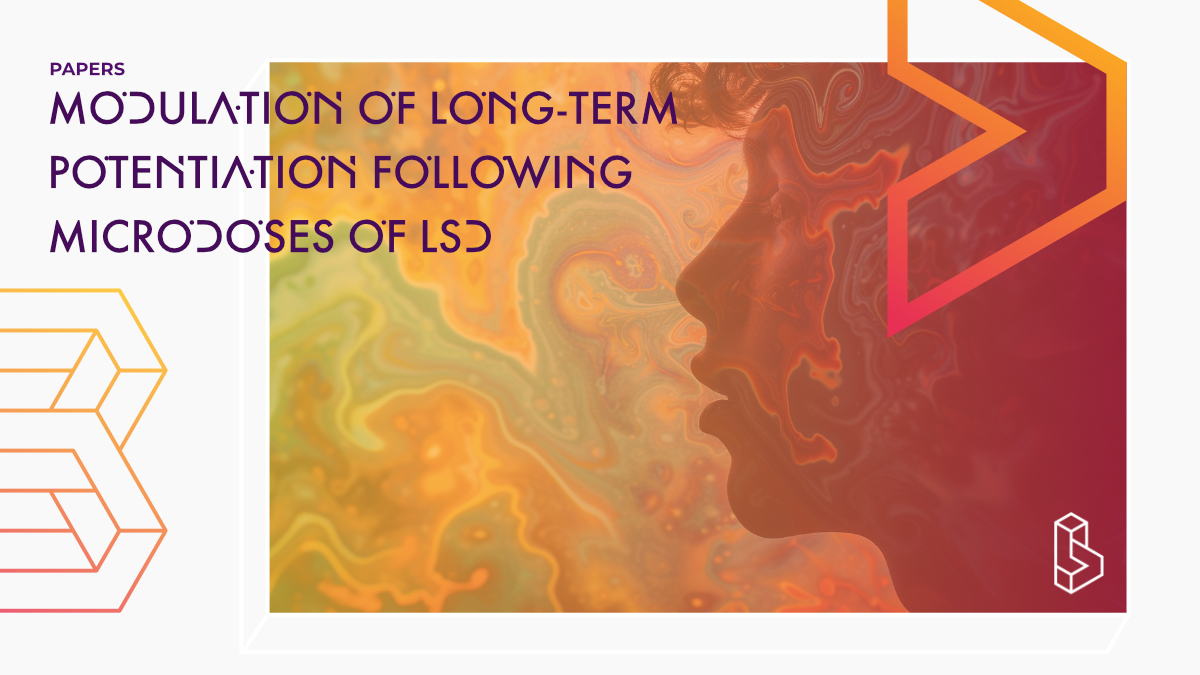This randomized controlled trial (n=80) investigated the effects of microdosed LSD (10µg; 14x) on neural plasticity using a visual long-term potentiation (LTP) EEG paradigm. Participants received either LSD or placebo and completed the visual LTP paradigm both acutely and after six weeks of repeated microdosing. While event-related potential (ERP) analyses didn’t show changes in visually induced LTP, dynamic causal modelling revealed alterations in laminar connectivity in the primary visual cortex, suggesting a more sensitive approach to assessing neural plasticity compared to traditional peak analysis methods.
Abstract of Modulation of long-term potentiation following microdoses of LSD
“Background: Microdosing psychedelics is a phenomenon with claimed cognitive benefits that are relatively untested clinically. Pre-clinically, psychedelics have demonstrated enhancing effects on neuroplasticity, which cannot be measured directly in humans, but may be indexed by non-invasive electroencephalography (EEG) paradigms. This study used a visual long-term potentiation (LTP) EEG paradigm to test the effects of microdosed lysergic acid diethylamide (LSD) on neural plasticity, both acutely while on the drug and cumulatively after microdosing every third day for six weeks. Healthy adult males (n = 80) completed the visual LTP paradigm at baseline, 2.5 h following a dose of 10 µg of LSD or inactive placebo, and 6 weeks later after taking 14 repeated microdoses. Visually induced LTP was used as indirect index of neural plasticity. Surface level event-related potential (ERPs) based analyses are presented alongside dynamic causal modelling of the source localised data using a generative thalamocortical model (TCM) of visual cortex to elucidate underlying synaptic circuitry.
Results: Event-related potential (ERP) analyses of N1b and P2 components did not show evidence of changes in visually induced LTP by LSD either acutely or after 6 weeks of regular dosing. However modelling the complete timecourse of the ERP with the TCM demonstrated changes in laminar connectivity in primary visual cortex. This primarily included changes to self-gain and inhibitory input parameters acutely. Layer 2/3 to layer 5 excitatory connectivity was also different between LSD and placebo groups. After regular dosing only excitatory input from layer 2/3 into layer 5 and inhibitory input into layer 4 were different between groups.
Conclusions: Without modulation of the ERPs it is difficult to relate the findings to other studies visually inducing LTP. It also indicates the classic peak analysis may not be sensitive enough to demonstrate evidence for changes in LTP plasticity in humans at such low doses. The TCM provides a more sensitive approach to assessing changes to plasticity as differences in plasticity mediated laminar connectivity were found between the LSD and placebo groups.”
Authors: Robin J. Murphy, Kate Godfrey, Alexander D. Shaw, Suresh Muthukumaraswamy & Rachael L. Sumner
Summary of Modulation of long-term potentiation following microdoses of LSD
Microdosing of psychedelics is an increasingly documented phenomenon that may have benefits for mental health and cognitive functioning, however the mechanism of action remains unclear.
Microdosing may modulate neuroplasticity, a process that is crucial to learning, memory, and other adaptive processes. Impaired neuroplasticity has been theorised to contribute to depression and cognitive decline in ageing.
Find this paper
https://doi.org/10.1186/s12868-024-00844-5
Open Access | Google Scholar | Backup | 🕊
Cite this paper (APA)
Murphy, R. J., Godfrey, K., Shaw, A. D., Muthukumaraswamy, S., & Sumner, R. L. (2024). Modulation of long-term potentiation following microdoses of LSD captured by thalamo-cortical modelling in a randomised, controlled trial. BMC neuroscience, 25(1), 7.
Linked Research Papers
Notable research papers that build on or are influenced by this paper
Pharmacokinetics and pharmacodynamics of sublingual microdosed lysergic acid diethylamide in healthy adult volunteersThis re-analysis of a Phase I RCT (n=80) examines the pharmacokinetics (how the body affects a drug) of LSD microdosing (10µg; 14x; 6w) in healthy adult males. The study established a one-compartment pharmacokinetic model showing an elimination half-life of 3.08h, found minimal physiological effects (<15% change in heart rate), noted possible influence of CYP enzymes on drug metabolism, and reported no changes in peripheral BDNF levels.
Multimodal creativity assessments following acute and sustained microdosing of lysergic acid diethylamide
This re-analysis of an RCT (n=80) finds no effect of LSD microdosing (10µg, x14) on creativity in healthy adult males. Participants received either LSD or placebo every third day for six weeks, with creativity assessed using multiple tests at baseline, during acute dosing, and after the six-week regimen.
Acute mood-elevating properties of microdosed LSD in healthy volunteers: a home-administered randomised controlled trial
This placebo-controlled, randomized, naturalistic study (n=80) of repeated microdoses of LSD (10μg, 14x, 6w) finds improved ratings, on dosing days, on creativity, connectedness, energy, and other wellness ratings. Though these transient changes were found, no enduring changes to mood and cognition were observed.
LSD increases sleep duration the night after microdosing
This Phase I RCT (n=80) examined the effects of microdosing LSD (10μcg; 14x; 6w) on sleep in healthy adult male volunteers, with doses self-administered every third day and sleep monitored through a commercially available sleep/activity tracker. The results showed that participants in the LSD group slept an extra 24.3 minutes per night on the night after microdosing compared to the placebo group, with no changes in sleep stages or physical activity.

